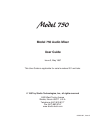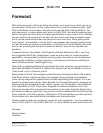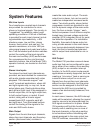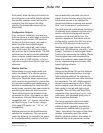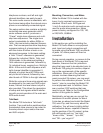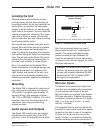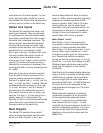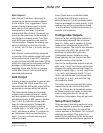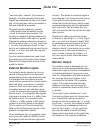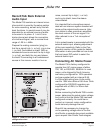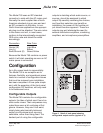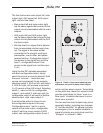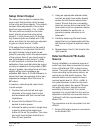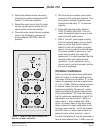
Issue 3, May 1997 Model 750 User Guide
Page 10 Studio Technologies, Inc.
Model 750
telephone numbers, and left and right
channel identifiers can easily be sent.
The voice audio source is selectable, with
the choices being either the internal micro-
phone or an externally-connected signal.
The setup section also contains a digitally-
controlled sine-wave generator which,
under software control, produces a
0-level single-tone reference and multi-
step tone sequences. The single-tone
output is selectable for either 400Hz or
1kHzthe two industry-standard frequen-
cies. The tone sequences allow frequency
response testing of a transmission chain,
with the choice of either a basic or an
advanced sequence. In the basic setting
a 1kHz 0-level reference is generated,
followed by individual 10kHz, 1kHz, and
100Hz tones. In the advanced setting a
1kHz reference is generated, followed by
14 individual tones, ranging from 15kHz to
50Hz. At the end of each sequence a left/
right channel identifier is generated. It
consists of a short burst of 700Hz sent
only to the left channel, followed by two
short bursts of 700Hz to the right channel.
While the voice and tone setup signals can
be assigned to the main and AUX output
buses, a direct line-level stereo output is
also provided. This allows the generation
of setup and test signals without interfer-
ing with normal operation of the main and
AUX audio buses.
Talk Back
The Model 750 includes a talk back
function. Two push-button switches allow
the selected voice source to be routed to
the setup direct output and/or the main
and AUX outputs.
Mounting, Connectors, and Mains
While the Model 750 is loaded with fea-
tures, it only requires two spaces in a
standard 19-inch rack. XLR-type and
¼-inch 3-conductor audio connectors are
used for audio interconnection. Mains
power is factory configured for 100, 120,
or 220/240V, 50/60Hz.
Installation
In this section you will be installing the
Model 750 Audio Mixer in an equipment
rack. Input and output connections will
be made using the Model 750s multitude
of jacks. AC mains power will then be
connected.
During normal operation, no access to the
back panel of the Model 750 is required.
However, there are five trim potentiom-
eters that may need to be adjusted prior to
the Model 750 going into service, depend-
ing on the requirements of the specific
installation. Since part of the calibration
process involves observing the front-
panel-mounted VU meters, you may want
to perform the calibration process on-the-
bench, prior to mounting the Model 750
in an equipment rack. In addition, there
are a number if DIP switches that may
need to be set. Refer to the Configuration
section of this guide for details.
Realistically, as long as you can get the
assistance of another person for about
5 minutes, go ahead and install the Model
750, wire it up, and then worry about the
calibration. You will need a highly-skilled
and articulate helper, capable of describ-
ing the position of the VU meters indica-
tors with words such as: too high,
down a little, almost, up a tad,
and OKyouve got it!



